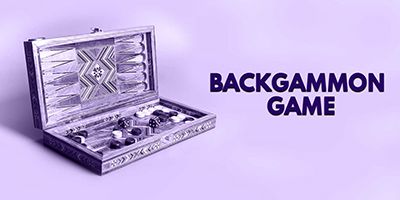What is Backgammon?
Backgammon has been played for almost 5,000 years, which is proof enough that it is a lot of fun. It's one of the oldest board games in the world right now! The backgammon board game appears difficult at first, but once you understand it, it's effortless.
Two players take turns moving pieces across the board and taking out the opponent's pieces from the board. The game has been played the same way for as long as historians can remember. But just as every rule has an exception, so does the backgammon game that developed around the world over the years.
You see! Backgammon dates back to almost 5,000 years ago, and the earliest evidence relating to the game was found among the ancient ruins of long-gone civilizations. It is indeed remarkable how this game has survived several millenniums, and maybe the answer to its durability lies in its simplicity.
Backgammon Game
Objective: Two players move their pieces across twenty-four triangular points on a dice-based board game, with the first person to remove all of their pieces from the board winning.
Equipment:
- Checker: Each participant has fifteen checkers of his or her own colour to play with.
- Die: Each player also has their own pair of dice and dice cup.
- Tracker: The stakes of the round are tracked using a doubling cube with the digits 2, 4, 8, 16, 32, 64.
- Board: The board is made up of 24 long triangles known as pips or points. The triangles are color-coded and separated into four quadrants, each with six triangles. The player's home board and outer board, as well as the opponent's home board and outer board, make up the four quadrants. The bar is a separator that runs along the centre of the board, separating the home and outside boards. The starting positions of the pieces are arranged as shown below.
How to Play Backgammon?
Since backgammon is a two-player game, it is played on a board with twenty-four narrow triangles or points; marked onto its surface. The vertical board looks fairly simple with the triangles on opposite sides of the backgammon board, and each player moves their pieces in opposite directions. The backgammon game triangles are color-coded and divided into four quadrants, each with six triangles. The quadrants relate to a player's home board and outside board, as well as the opponent's home board and outside board. A ridge running down the centre of the backgammon board game separates the home and outer boards. And that's how you play backgammon.
When playing the backgammon board game, the players sit on opposing sides of the board, facing each other. The home board for each player is in the right-hand quadrant nearest to the player. The outer boards, which are in the left quadrant, are opposite each other, as are the home boards.
The player who properly knows how to play backgammon moves his checkers counterclockwise in a horseshoe pattern from the direction of the other player's home backgammon board game.
On most backgammon boards, the triangles are numbered from 1 to 24, with the 24th point being the farthest point from the player and 1 being the rightmost triangle on the player's home court. The players must move their pieces from opposing sides of the board, so one player's first point is the other player's 24th point, and so on.
Backgammon Rules
The goal of the backgammon board game is to get all of your checkers into your own home board before bearing them off. The backgammon board game is won by the first person to bear off all of their checkers.
- Automatic Doubles: The stakes are increased if two consecutive numbers are thrown on the initial roll. The doubling cube is rotated to 2 and placed in the centre. The number of automatic doubles per game is usually limited to one by the players.
- Beavers: When a player gets doubled, he has the option to immediately redouble (beaver) while still holding the cube. As with a conventional double, the original doubler has the option of accepting or refusing.
- The Jacoby Rule: If neither player has offered a double during the game, gammons and backgammons are counted as a single game. This rule expedites play by removing circumstances in which a player skips double in order to continue playing a gammon.
Backgammon Game Strategy
The goal of the backgammon board game is to get all of your checkers onto your own home board before bearing them off. Each player rolls a single die to begin the backgammon game, and the player with the higher number moves first, using both numbers rolled. If both players get the same number, the dice are re-rolled until they get separate results. After that, the players take turns rolling two dice at the start of each turn. The dice must always be rolled together and dropped flat on the game board's right side. The dice must be rolled again if it lands outside or on a checker.
Backgammon Game:
-
Moving
- The number of points the player must move its checker is determined by the dice throw. The checker goes ahead in a horseshoe pattern toward the player's home board. And that my friends are the beginning of how to play backgammon.
- A point that is not occupied by two or more opposing checkers is called an open point. A checker can only land on an open point as it moves.
- The two dice represent two distinct moves. If a player rolls a 6 and a 4, for example, he may move one checker 6 spaces and another checker 4 spaces to an available point.
- The numbers on the dice are played twice when a double is rolled. If a player rolls two fives, for example, he can advance his checkers five points four times in any combination, landing on open points.
- If feasible, a player must relocate both rolled numbers (four numbers if a double is rolled). If just one of the numbers can be played since there is only one open point, the player must do so. If neither of the numbers can be played, the more significant number must be played. If neither number can be played, the player's turn is forfeited. In the case of a double, if a player cannot play all four numbers, he or she must play as many numbers as possible. The rules don't differ when you are playing backgammon online either.
-
Hitting
- A blot is an open point with one opposing checker. The blot is hit when a checker is moved onto it, and the opposing checker that has been hit is placed on the bar.
- When a player has one or more checkers on the bar, he must re-enter them onto his opponent's home board first. A checker enters by rolling two dice and relocating one of the numbers on the opponent's home board to the equivalent position on the checker's home board.
- The player loses his turn if the checker(s) on the bar cannot enter an open point, and the checker(s) remains on the bar. A player is not allowed to move any further pieces until all of his checkers have been removed from the bar. A player's turn ends when he or she is able to enter some but not all of his checkers off the bar. Any unused number must be played if a player's checker(s) have been moved off the bar.
-
Bearing Off
- When all of a player's checkers are in his home board, he can begin bearing off, which is the process of withdrawing them. This is accomplished by rolling a number that corresponds to a point on which a checker is located.
- If no checker can bear off with the number(s) rolled, the player must make a valid move(s) with a higher point checker(s).
- If a player has borne off all fifteen of his checkers and the opponent has borne off at least one checker at the end of the game, that player wins the current stake. If the opponent does not have any checkers, he or she loses a gammon and doubles the existing stakes. If the opponent hasn't borne off any checkers but still has one or more on the bar, the opponent loses backgammon and triples the existing stakes.
-
Doubling
- At any moment throughout the game, a doubling cube is used to raise the stakes. The doubling cube is put on the bar with 64 facing upwards at the start of the game.
- A player may propose to double the current stakes before the roll on his or her turn. The opponent has the option of accepting (taking) the doubled stakes or resigning (dropping) and losing the match and existing stakes.
- If the opponent takes it, he becomes the cube's owner, and the cube is turned over with the number 2 facing up. Only the cube's owner has the power to propose doubling the stakes again after that (redouble).
- If the opponent takes, he receives ownership of the cube, and the process can continue from 4 to 8 and beyond. Even though the largest number on the cube is 64, there are no boundaries to redoubles.
Cheating In Backgammon Game
It may sound cliche, but a common perspective about rules is that they are meant to be broken. We believe that there are a lot of people who will go to great lengths to ensure a win in a backgammon board game.
This section about cheating in a backgammon game is a heads-up for players who love the game and want to play by the rules. Please understand that breaking the rules is frowned upon by respectable and honorable players who would never resort to the tactics mentioned below:
Your opponent can use one of these tools, or even all of them together.
This cheating tactic in the backgammon board game is performed by a player when the opponent least expects it, right under his nose. The player will take steps with the checkers, and move them as quickly as possible to the desired point. For example, when a 6 is rolled, the player will take a 7 or 5, whichever is more convenient. But they will count up to six every time they step, making sure not to point the checker on the board every time they count. This diverts the opponents' attention. Just slide them in or place them directly. They will adjust the speed so they can cheat by a place of two, and place the checker once they have finished counting.
Another way to cheat in backgammon games is to prepare another set of 'winning dice," which will ensure that they are always rolling the right amount of doubles. These dice are usually hidden behind them or tucked up their sleeves, ready to be swapped out when it's their turn to roll. This is also a good method once they have cornered you at their home, and the only number that is free is number one. With the cheating dice, they will automatically roll higher numbers and not let you get back into the game.
The last way to cheat is to give the backgammon board game an occasional push so that you have to rearrange the checkers. Just place some checkers to your advantage and some of your opponent's checkers to your advantage, and do not make it too obvious. This is one of the easiest ways to cheat in backgammon without raising suspicion.
Now you have all the tools you need to successfully identify a cheat in the backgammon board games.
Irregularities in Backgammon
Backgammon is a game that is subject to many irregularities, as there are several idiosyncrasies that can occur during play. These irregularities can range from a simple mis-roll of the dice to a more serious breach of the rules.
One of the most common irregularities in backgammon games is when a player rolls the dice and fails to move their pieces. This can happen if the player rolls too quickly, or if they are distracted and don’t remember to move their pieces. It is important for players to pay close attention to their rolls and make sure to move their pieces if they roll a valid number.
Another common irregularity is when a player makes an illegal move. This can happen if a player moves their pieces in the wrong direction or tries to move a piece to a space that is already occupied. It is important for players to read the rules of the game carefully before they start playing to ensure they are familiar with all the legal moves.
Finally, a more serious irregularity is when a player makes a cheating move. This could be anything from trying to change the dice roll after the fact, to trying to move their pieces in a way that would give them an unfair advantage.
The Differences Between Poker vs Backgammon
Poker |
Backgammon |
|
The cards are dealt, and the players place their wagers at the beginning of a poker game. |
In backgammon, each player rolls one die onto his right side of the board at the start of the game. |
|
When a player raises an illegal sum in poker and his opponent calls, the pot is pushed, a new hand is dealt, and the mistake remains. |
If a player makes an illegal move in backgammon, such as moving nine pips after rolling a 4-3, either my opponent or I can remedy the problem, but only before he rolls his dice. |
|
Poker players memorize the odds of a flush draw. |
A seasoned backgammon player knows how many shots are required to hit direct (six pips or fewer) and indirect (seven or more pips removed) blots. |
Play Online Poker & Earn Real Cash Daily
When you play poker online, you have a lot of opportunities to make money online. Here are some reasons why you should play poker and earn real cash daily.
- You can make real money to add to your income.
- You can learn essential life skills.
- You learn how to read people if you play live poker in a casino.
Backgammon Game FAQs
Q.1) How do u play backgammon?
Backgammon is a two-person game in which one player sits on each of the four quadrants of the board. There are six points in each quadrant. The fundamental goal of the game is for a player to remove all of their checkers off the board by following the Backgammon rules and playing the backgammon board game correctly.
Q.2) Is backgammon a skill or luck?
Backgammon is a skill game, and the higher your skill level, the more likely you are to win. Tournament and match outcomes have been confirmed this time and time again. However, it can only be proven over time. In the short run, just about anyone can beat just about anyone if they have enough luck, and dice are luck.
Q.3) Why was backgammon banned by the Catholic Church?
Back in the day, the Catholic church didn't approve of a number of things. Backgammon was one of these things, which they outlawed in the sixteenth century. They ordered the boards to be destroyed, along with a number of other banned publications.
Here are Some Other Similar Games to Backgammon:


